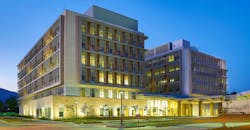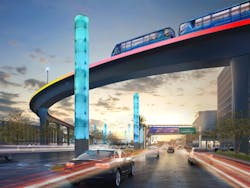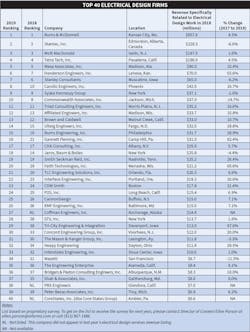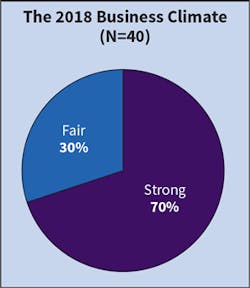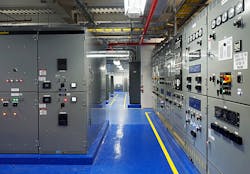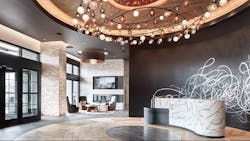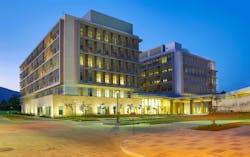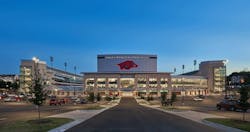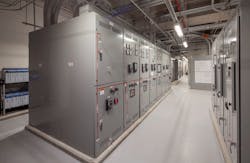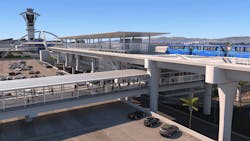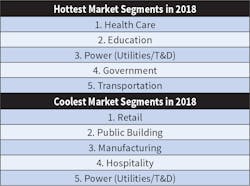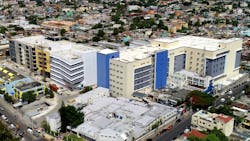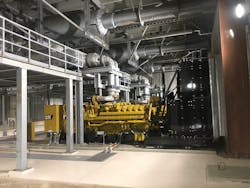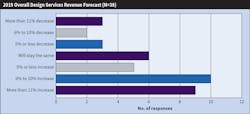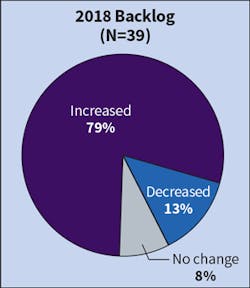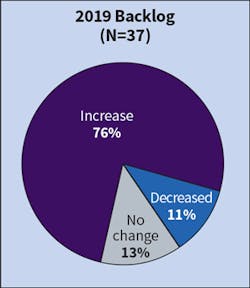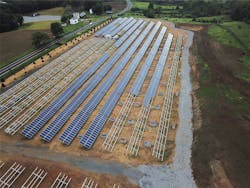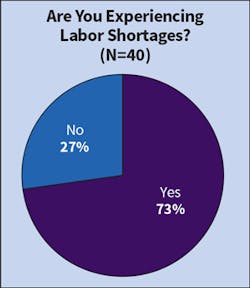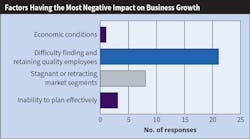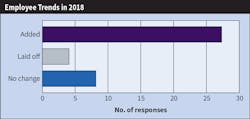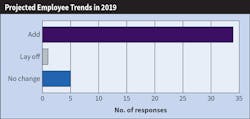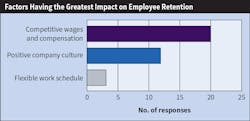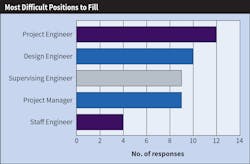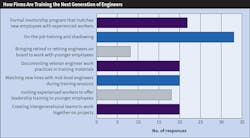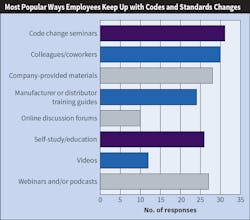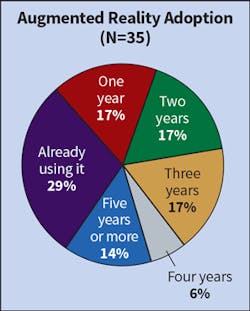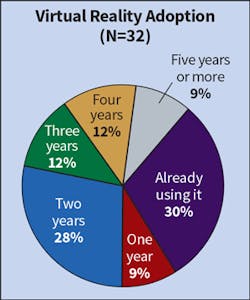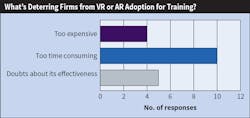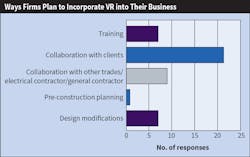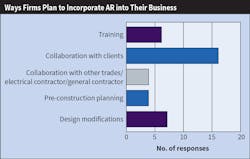Designs on the Future: EC&M’s 2019 Top 40 Electrical Design Firms Special Report
Though a much-ballyhooed formal “Infrastructure Initiative” for the nation has yet to issue out of Washington, D.C., an infrastructure initiative — lower case — seems to have been agreed on informally by emboldened investors, carrying the fortunes of builders, architects, engineers, and designers along with it. In other words, the market is building, upgrading, and improving stuff of all kinds at a pace that’s seemingly settled into a predictable rhythm. Credit goes to an economic climate creating an appetite for abundant private sector risk-taking and a green light for more select public sector investment.
While it may be a stretch to call what’s now happening a “boom,” building and construction work largely remains robust yet unclouded by much tangible evidence of an impending slowdown.
PBS Engineers designed the power and lighting infrastructure associated with the Automated People Mover Guideway and Train Control power components at LAX. The firm designed all utilities and conduit infrastructure that is routed through the Guideway for the People Mover (photo courtesy of PBS Engineers).
It’s against that backdrop that one select group of beneficiaries — leading electrical design firms — tell EC&M that business is strong, revenue is growing, more design talent is needed to meet demand, and that the good times show no sign of abating. Those and a host of other compelling insights come from EC&M’s annual Top 40 Electrical Design Firms survey, an inquiry into the state of business and important trends, concerns, and opportunities facing companies whose reported 2018 electrical design revenues range from a low of nearly $7 million to a stratospheric $858 million reported by a lone outlier (see Top 40 Rankings Table).
Combined, the 2019 Top 40 say they brought in $2.34 billion in 2018 designing and engineering the myriad electrical components of client projects. That revenue number was 6.4% higher than the $2.22 billion the 2018 Top 40 firms reported booking in 2017, which was 3.4% higher than that reported by the 2017 Top 40. Those two years of growth, though, were tepid compared to the 2016 Top 40’s 16% growth, and the 2015 Top 40’s 28% advance (numbers posted as the economy was in fast-acceleration mode coming out of the Great Recession of a decade ago).
Those go-go years may be in the rearview mirror, but slow and steady revenue growth in a seemingly healthy building and construction economy that increasingly demands strong talent to design extensive and innovative electrical infrastructure appears to suit many design firms. Add that all up, and 70% describe last year’s business climate as “strong,” the highest number in the last three years of surveys (Fig. 1).
Fig. 1. The number of firms
characterizing the 2018 business
climate as “strong” inched up from
65% in 2017 to 70% in this year’s
survey. Also like last year, no firms
considered the climate as “weak.”
And it’s probably no coincidence that for the first time in three years as well, a majority (64%) said their revenue had topped expectations (Fig. 2). Moreover, that number has surged; last year, 45% polled said revenues came in higher than anticipated, while 35% said they had an upside surprise.
Fig. 2. The number of firms
“exceeding” revenue expectations
in 2018 rose by 19%, going from
45% in 2017 to 64% this year.
PBS Engineers, Inc. (No. 38), Glendora, Calif., saw revenues double to $7 million last year, largely a result of having won MEP design work on some large construction projects in the Los Angeles area. The firm began getting revenue streams from work on a city contract for an automatic people mover and other elements of a $500-million upgrade of Los Angeles International Airport, and work on the city’s new sports stadium.
“The reputation we’ve gained, especially in aviation and transportation design work, enabled us to break through a new threshold that we hope will bring managed growth going forward,” says Company President Kunal Shah.
Electrical work accounts for about 60% of the firm’s design/design-build revenues and is the company’s “strongest discipline,” Shah says, allowing it to secure many electrical-only projects. That expertise, combined with a strong economy and growing demand, has enabled it to concentrate on the California market, but Texas is now being evaluated for expansion, says Shah.
Last year was another strong one for Burns & McDonnell (No. 1), as it rode big macroeconomic trends that spurred continued investment in markets as varied as the nation’s power infrastructure, renewable energy projects, warehousing and distribution facilities, and petrochemicals processing. The Kansas City, Mo.-based company’s electrical design revenue grew 4% to $858 million, with much of that coming from the power transmission and distribution market — its bread and butter.
Electrical room within Duke University’s chilled water plant #2, which was expanded to accommodate the required 40,000-ton capacity to cool the campus (photo courtesy of Affiliated Engineers/Mark Herboth Photography).
Company chairman and CEO Ray Kowalik says the 2018 business climate was favorable and revenues grew because electrical-intensive projects are proliferating amidst growth in commerce, an increasingly stressed infrastructure, and the continued buildout of an aging and evolving electrical grid.
“Cheap, abundant energy is behind a lot of this growth, but at the same time we’re seeing the continued penetration of renewable energy into the market, which is raising questions of how to bring more of that online while meeting the growing load demand,” he says.
The main entry lobby of Two Light Tower features custom pendant lighting that was provided by the owner for installation by the construction team at Faith Technologies (photo courtesy of Faith Technologies).
The company brought its T&D design-build expertise to bear in a project with utility PacifiCorp to bring two high-voltage substations online in Wyoming. They were needed to bolster system reliability with the recent addition of 1,000MW of new wind generation capacity. Last year also saw the company begin design work on a 138/12kV substation for Dominion Privatization Texas that will similarly help reliably integrate substantial wind energy assets.
Projects with Promise
As renewable energy advances, such projects are likely to be near the top of the list of new revenue streams for electrical designers in coming years. The growth of solar and wind power increasingly demands engineering expertise enabling effective production, transmission and distribution, as well as integration into the grid. And it will also require energy storage, an element of renewables that, by itself, could be a major source of design business. Of several commercial building project types that could be candidates for contributing more to the top line over time, energy storage systems drew the most mentions (Table 1). On last year’s survey, that choice got the third-most mentions — possible evidence of spreading client interest.
Table 1. When asked to rank common project types from most
to least potential for revenue growth, Top 40 firms named energy
storage work most promising followed by back-up power.
But also drawing more interest is the closely related issue of back-up/on-site power. Designers ranked such systems second on the list of prospective revenue accelerators in the building space. The evident reason: mounting interest in ensuring that power can be accessed should grid access be interrupted.
The eighth floor facility amenity space of Two Light Tower was highlighted by lighting features constructed into the walls, perimeter recessed indirect lighting, and blue lighting matching the facility branding to name a few (photo courtesy of Faith Technologies).
“Energy resiliency and reliability is a bigger thing, the whole idea of hardening systems to allow a facility to maintain operations,” says Krista Murphy, partner at Affiliated Engineers, Inc. (No. 12), headquartered in Madison, Wis. “That’s translating to more interest in the design of distributed energy resources like microgrids, batteries, and solar PV.”
Concord Engineering Group, Inc., (No. 30), Voorhees, N.J., saw its revenue grow 20% last year, partly because of an uptick in demand for engineering improvements to harden and insulate facility electrical infrastructure.
Electrical design for the $1.1-billion, 1.5-million square-foot new U.S. embassy compound in Islamabad, Pakistan, included a protected electrical utility distribution system. This included a low-voltage site distribution system for safe haven areas installed underground (Photo courtesy of Mason & Hangar).
“Extended power outages are a major concern,” says Dilip De, vice president of transmission and distribution for the firm. “In the event of another Hurricane Sandy (the devastating 2012 East Coast storm), more facilities are looking at better standby systems that involve backup power and repositioning generators and other electrical equipment above flood levels.”
De says one 2018 project involved major infrastructure upgrading and relocating the main 26kV service and 13.2kV distribution switchgear at Hackensack (N.J.) Medical Center and adding a central emergency generation system. The other major engineering and design and construction work also continued a new 10MW stand-by power plant capable of black start and supporting extended period of island mode operation to support one of New Jersey’s largest wastewater treatment pumping stations. The project will prevent the facility from future flooding and extended power outage during adverse weather conditions.
The electrical scope on the Donald W. Reynolds Razorback Stadium at the University of Arkansas encompassed the full range of electrical services at the firm — from a new medium-voltage distribution loop around the stadium to architectural lighting design (photo courtesy of Henderson Engineers/Populous).
That quest for more control, and its link to electrical systems capabilities, is evident in other project types that could grow firms’ electrical design billings over time. Lighting and control systems ranked third on the revenue-prospect list, and building management/automation systems ranked fourth. Both demand specialized and innovative designs and products that can push the envelope of design expertise but could offer solid payback in new business.
Kevin Rettich, a buildings engineering leader and vice president at Stantec, Inc., (No. 2) Edmonton, Alberta, sees demand increasing for buildings that use connected lighting systems as a backbone for lighting controls and the capture of data needed to make buildings “smart.” Interest is growing in designs that use Power-over-Ethernet (PoE) technology to accomplish those functions, requiring Stantec to expand its knowledge and capabilities base.
Post Hurricane Ike, the University of Texas Medical Branch-Galveston constructed a second utility plant in an effort to increase the level of resiliency on the campus ahead of future natural disasters. Elevated 18 feet above ground level, the plant houses two chillers, a gas-fired combined heat and power system, and heat recovery steam generator (photo courtesy of Affiliated Engineers /Thomas McConnell).
“We’ve had to change focus and bring our IT people more into design work alongside electrical engineers,” he says. “It’s caused us to rethink our electrical design work in the buildings space because power is coming more from the head-end room, not from the panelboard.”
Even a specialist in the water/wastewater systems design market rates building lighting and controls a top revenue-growth prospect. Ron Burdick, instrumentation engineer at Carollo Engineers, Inc., (No. 8), Phoenix, says the company has dedicated several staffers to understanding lighting-related requirements set out in energy codes like California’s Title 24.
PBS Engineers designed the full power and lighting systems for the East CTA APM Station at LAX. The scope included providing electrical infrastructure for all components within the station (photo courtesy of PBS Engineers).
“Fixtures are becoming more connected on some of the big facility campuses where we work, so understanding PoE and wireless and the engineering and commissioning needed is more important than ever,” he says.
Markets with Staying Power
Though Carollo continues to see heavy demand for electrical design services in the water/wastewater market — its billings increased nearly 17% in 2018 — that market wasn’t among those top firms in the aggregate considered especially “hot” last year. It ranked second on that list in 2017, but fell off this year’s top-five list, which was topped by health care, education, and power/utilities/T&D, markets driven by a mix of changing demographics, aging infrastructure and new technologies (Table 2).
Table 2. Strangely enough, power, which was
overwhelmingly ranked as the most active market
last year, showed up on both the hottest and
coolest lists this year.
Health care and education have long been key markets for TLC Engineering Solutions, Inc., (No. 21), Orlando, Fla., and should remain strong due to new construction and interest in improving existing facilities, says James Ferris, president and COO. Health care facilities, he says, will need to confront issues like redundancy and power quality, which will demand specialized design knowledge.
“Health care is about 40% of our business, and it’s one that is more expertise-led in design and less commoditized — something you can travel with,” Ferris says.
The Hackensack University Medical Center expansion project requires upgrading of existing electrical infrastructure that includes replacement and relocation of the 26.5kV main service substation, consolidation of a 13.2kV distribution system, and building a Central Utility Plant, including a centralized 7.5MW new emergency power generation system, for the hospital (photo courtesy of Concord Engineers).
But for many firms, markets can and do change over time. Concord saw its water/wastewater, renewables and health care business continue to grow in 2018, but watched traditional power work, ranked high on lists of both hot and cold markets by designers, continue to erode.
“Large power work has had a big downturn,” De says. “In the late ’90s it was booming, but those are rarer now. We’ve shifted gears to smaller, distributed energy, microgrid work (which the company cited as its top 2019 business challenge).”
Burns & McDonnel’s critical T&D work growth moderated some last year, Kowalik says, but others (among the dozen or so it considers solid growth prospects) filled the gap — and even some left for dead are returning.
This new 1.65-million square foot medical campus with more than 600 beds and surgical suites will be the largest single medical complex in the Caribbean when completed this year (photo courtesy of Triad Consulting Engineers).
“One I’m seeing return to us is the chemicals market,” Kowalik says, noting the economics of that industry have been changing. “We’ve signed up several big projects on the Gulf Coast; we haven’t put a lot of money and effort into that market in a while, but it seems to be coming back in a big way.”
Some designers are taking an opportunistic approach to markets, going where the demand is growing. PBS, says Shah, has been ramping up its involvement in the hotel/hospitality arena. It’s landed work on the Los Angeles convention center and is anticipating opportunities there and elsewhere as the 2028 Olympics draws closer. It’s also seeing new opportunities in the laboratory and horticultural lighting markets.
Side view of the three generators installed at the Draper Water Treatment Plant in Oklahoma City (photo courtesy of Carollo Engineers).
“We’ve seen some requests for proposals for medical marijuana-related lab projects,” he says. “We were involved in a planning study on one.”
Optimism Abounds
Indeed, in good times jobs seem to come out of the woodwork, and that’s what many top designers are seeing, prompting nearly half to say they expect 2019 revenue growth to lean toward double digits (Fig. 3). Twenty-four firms expect 2019 growth of 5% or more, up from 20 last year. Only eight firms predicted a decrease, though that number is up from five last year.
Fig. 3. As in the past, the vast majority of firms on the Top 40 list are expecting revenue to stay the same or increase in 2019.
Most design firms also say their backlog increased in 2018 (Fig. 4) and should increase again this year (Fig. 5), suggesting many are booking new work even as they allocate resources to work already in the pipeline. It could also mean that, due to productivity constraints, companies are struggling to push projects out the door.
Fig. 4. More than three-quarters
of Top 40 firms posted an increase
in their backlog in 2018, 65% of
which fell in the 0% to 10% range.
Fig. 5. Only nine firms on this
year’s Top 40 list expect their
backlog to decrease or stay
the same in 2019.
But even as more than three-quarters say their backlog is rising, it may be noteworthy that the percentage projecting an increase has been trending steadily down, while expectations of a decrease have been rising, which could be read as bearish. While 76% say it will increase this year, 86% of the 2018 Top 40 and 95% of the 2017 roster expected an increase. Eleven percent expect a decrease this year, a rise from 3% last year and 5% a year earlier. Worth noting though: 13% said backlog did decrease this year, but only 3% of last year’s firms said they were expecting that outcome for 2018. Similarly, 86% of the 2018 Top 40 said it would increase, but a year later 79% said it did.
That disconnect aside, firms express overall bullishness for the near term. With some evidence that 3% GDP growth may be attainable and sustainable, buttressed by some building and construction trends that could have electrical work as a centerpiece, many are gearing up to absorb more work.
The College of Health and Human Development Biomechanics Lab renovation at Pennsylvania State University enhances advanced research in adaptive human movement (photo courtesy of Gannett Fleming).
Anticipating more revenue from new ongoing maintenance-oriented design and construction services with a few water clients — and the continued exit of design firms from the water specialty — Carollo expects 10% to 15% growth this year, Burdick says. “As they lose water focus, we’ll pick up more work.”
Affiliated mid-year was on track for 6% to 10% growth and was seeing few signs of a feared economic slowdown. “At the beginning of 2018, we thought we’d see a downturn this year, but we haven’t,” says Murphy. “We’re continuing to focus on building relationships with clients that will lead to more work.”
TLC also is counting on steady work from existing clients as well as some geographic expansion to deliver at least 5% growth. But also concerned about a slowdown, the company has been trying to prepare.
A new solar field is being added on this plant expansion project to increase solar generation to 7.5MW. When completed, the project will be Net Zero, which means it will produce 100% of its annual power needs (photo courtesy of Triad Consulting Engineers).
“We’ve done some studies comparing where we’re at now to where we were in 2006 and 2009 (the last recession period),” Ferris says. “At some point we’ll hit a recession; we just don’t know when.”
Should growth targets not be hit, many firms suggest it won’t be for lack of opportunities. Instead, the single biggest culprit will be staffing. By far the biggest business challenge for 2019, as well as the most formidable obstacle to business growth, is finding and keeping good design talent, leading firms say, echoing previous surveys (Fig. 6).
Fig. 6. Slightly fewer survey
respondents (73% this year
compared to 76% last year)
indicated that their firm was
having issues with labor
shortages.
Most responses to the open-ended top-2019-business-challenge question referenced staffing concerns. Among the specifics: a dearth of mid-level engineers, seen key for effective production teams; funding competitive compensation packages; attracting talent in a seller’s labor market; boosting productivity in a competitive, fee-pressured market; and finding seasoned electrical engineers with both power and lighting design experience.
Talent Still Needed
Seeing growing demand, and eager to take on more design work without overcommitting, many firms continue to struggle with keeping their ranks full. Most again say they’re experiencing labor shortages even in a period when net staffing is probably increasing (Fig. 7). Most said they added employees last year, though that number fell by 13% from last year’s survey. And, like last year, 85% said they expected to hire engineers this year (Fig. 8 and Fig. 9).
Fig. 7. Not surprisingly, finding and retaining top talent is the single most challenging task for Top 40 firms.
Fig. 8. Like last year, most Top 40 firms continued the trend of adding headcount in 2018.
Fig. 9. It looks like the trend toward recruitment of employees will continue this year, as 34 Top 40 firms plan to add headcount this year.
David Tucker, technical strategy leader — electrical and power systems for CDM Smith (No. 23), Boston, says finding experienced engineers “is as tough as it’s been my entire career.” Seasoned talent, he says, is important as the company expands and prioritizes close customer interaction.
“We can do a lot of our work with younger staff, but clients want to interact with people who have the background and technical knowledge and understand the work,” he says.
Carollo Engineers completed electrical improvements at the KAW Pump Station for the City of Stillwater, Okla., adding 600 hp of pumping capacity (photo courtesy of Carollo Engineers).
Given electrical design technical and business trends, firms say they need a blend of youth and experience. New graduates may have training and interest in some of the emerging areas of design, such as lighting controls, PoE, and renewable energy, but experienced staffers have an edge in soft skills, plus deep knowledge in core areas.
“That 10-year person is hard to find, and supervising engineers are harder to find,” says Ferris.
That elevates the need to retain top talent, especially when workers are more mobile. Many variables come into play in limiting employee churn, but a nearly a third of firms say cultivating a “positive company culture” is part of the equation (Fig. 10).
Fig. 10. Taking a deeper dive into the labor shortage issue, the survey revealed three factors Top 40 firms identified as having the greatest impact on retaining employees.
Stantec also is challenged to find those with 10 to 15 years of experience. Rettich says they’re vital in project-lead roles, ones that have been chronically difficult to fill. Respondents named “project engineer” among the toughest positions to staff (Fig. 11). Over the past three surveys, that title and “project manager” have logged the most mentions.
Fig. 11. As it has for several years in a row, “project engineer” came up as the most difficult job title to fill for Top 40 firms. However, “design engineer” was a close second.
Training the Next Generation
Keeping the ranks filled is important but, so too, is keeping employees well-educated and trained. With a wave of Baby Boomer retirements looming, firms are exploring how best to transfer their knowledge and experience to replacements. Half or more of respondents now say they’re using at least one of five approaches, the two most popular being on-the-job training/shadowing and formal mentorships. Of note, last year no single tactic drew more than 17 mentions (Fig. 12).
Fig. 12. Top 40 firms use a varied approach to training; however, several methods stood out as the most popular, including on-the-job training and shadowing,
mentorship programs, and matching new hires with industry veterans.
Concord emphasizes on-the-job training for efficiency, says De, and a common area of need is giving young engineers a grasp of T&D concepts. “They can be very light on power systems work straight out of school.”
While those on-the-job methods are popular, firms also employ formalized training. And they’re turning to that largely for assistance with emerging elements of the design process. More said employees need training support in power systems analysis, electrical design software, and selective coordination than in fundamentals like short-circuit analysis and bonding and grounding (Table 3).
Table 3. Respondents report needing training in multiple areas,
with power system analysis, electrical design software, and
selective coordination topping the list.
Support for deciphering the National Electrical Code (NEC) ranked comparatively low, but knowledge of codes and standards, generally, is clearly essential. But staying current can be difficult, given frequent revisions. Firms use a variety of approaches, ranging from seminars and monitored self-study to webinars and vendor training, ruling out few (Fig. 13).
Fig. 13. Top 40 firms say employees stay up to date with codes and standards in a multitude of ways, but these categories are the most influential.
C‑DM Smith, says Tucker, uses a mix to ensure designers understand something that’s both important and harder to grasp.
“IEEE color books, for example, have been subdivided so they’re easier to digest, but the downside is users have to be more aware of how they all interact and link,” he says.
Fig. 14. The scales seem to be
turning when it comes to AR adoption.
Last year, the majority of firms said it
would be at least five years before they
used it, and this year you can see that
thinking is changing.
Fig. 15. Slightly more firms are
already putting AR than VR into
practice, although a good portion
have yet to adopt the technology.
Training and hiring are difficult yet essential tasks for design firms. But, over time, emerging technology could make them less burdensome. One advance is enhanced reality, a byproduct of advanced computer modeling and simulation tools that could improve productivity in project design and construction phases. About a third of the Top 40 say they’re using two types — augmented and virtual reality — to some degree in their work (Fig. 14 and Fig. 15), with the balance saying it’s a ways off because, for now, it’s too cumbersome to learn, prohibitively expensive or of questionable value (Fig. 16). From what they may know about it now, though, firms see client collaboration as AR/VR’s chief utility (Fig. 17 and Fig. 18).
Fig. 16. The greatest deterrent from using virtual reality or augmented reality simulators for training among Top 40 firms is time.
Fig. 17. As is the case with AR, Top 40 firms overwhelmingly indicated they plan to use VR for collaboration with other trades.
Fig. 18. Top 40 firms overwhelmingly indicated they plan to use AR for collaboration with clients.
Those using AR and VR in electrical work say applications are varied. TLC uses them to “help clients understand how their constructed space will function”; Affiliated uses VR to “allow clients to visualize electrical equipment rooms and above-ceiling conditions; Burns & McDonnell says it’s using VR to help a client “reduce the number of physical inspections needed in hazardous electrical installations”; and Stantec characterizes VR as “useful in helping explain the detailed electrical design as well as multi-disciplinary/contractor coordination.”
In a way, the advance and promise of AR and VR, while beginning to blossom in the design arena, may be a metaphor for the emerging landscape that electrical designers must navigate. Firms today must know not only the technical aspects of design but also be able to use people and technology to produce efficiently, collaborate and communicate effectively with partners and clients, and adapt quickly to changes. All of that is certain to grow in importance as near-term demand for comprehensive design services shows little evidence of abating.
About the Author
Tom Zind
Freelance Writer
Zind is a freelance writer based in Lee’s Summit, Mo. He can be reached at [email protected].
